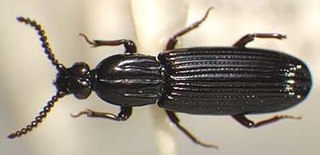
Arthur Gardiner Butler F.L.S., F.Z.S. was an English entomologist, arachnologist and ornithologist. He worked at the British Museum on the taxonomy of birds, insects, and spiders.
Rhysodinae is a subfamily in the family Carabidae. There are 19 genera and at least 380 described species in Rhysodinae. The group of genera making up Rhysodinae had been treated as the family Rhysodidae in the past, and subsequent DNA analysis then placed it within Carabidae, where it was sometimes treated as the tribe Rhysodini, but the most recent analyses place it as a subfamily in a clade along with subfamilies Paussinae and Siagoninae, forming a sister to the remaining Carabidae.

Clinidium is a genus of wrinkled bark beetles in the subfamily Rhysodinae. Most species are Neotropical, but some occur further north in North America and there is also one species in Europe and one in Japan. Two species are known from Miocene amber.

Rhyzodiastes is a genus of beetles in the family Carabidae, containing the following species:

Dhysores is a genus of beetles in the family Carabidae. It is confined to Africa.

Tangarona is a genus of wrinkled bark beetles in the family Carabidae. Tangarona pensa, found in New Zealand, is the only species of this genus.
Arrowina is a genus of wrinkled bark beetles in the family Carabidae. The genus occurs in Asia, with records from at least Sri Lanka, southern India, Nepal, Thailand, Sumatra (Indonesia), and Japan.

Omoglymmius is a genus of wrinkled bark beetles in the subfamily Rhysodinae, found on every continent except Africa and Antarctica. There are at least 150 species in Omoglymmius.
Omoglymmius cupedoides is a species of beetle in the subfamily Rhysodinae. It was described by R.T. Bell & J.R. Bell in 1993. It is known from Madang, Papua New Guinea, where it was collected in 1896.
Omoglymmius multicarinatus is a species of beetle in the subfamily Rhysodinae. It was described by R.T. Bell & J.R. Bell in 1993. It is known from the northern peninsula of Sulawesi, Indonesia.
Omoglymmius sabah is a species of beetle in the subfamily Rhysodinae. It was described by R.T. Bell & J.R. Bell in 1993. It is known from Mount Kinabalu in Sabah, Malaysian Borneo. The type series was collected at elevations of 500–900 m (1,600–3,000 ft) above sea level.
Clinidium incis is a species of ground beetle in the subfamily Rhysodinae. It was described by R.T. Bell in 1970. It is endemic to Puerto Rico. The specific name is derived from the Latin incus and refers to the type locality, El Yunque, which is the Spanish word for anvil. Grammatically, the spelling should have been incudis.
Clinidium curvicosta is a species of ground beetle in the subfamily Rhysodinae. It was described by Louis Alexandre Auguste Chevrolat in 1873. It is endemic to the Sierra Maestra in Cuba.
Clinidium granatense is a species of ground beetle in the subfamily Rhysodinae. It was described by Louis Alexandre Auguste Chevrolat in 1873. It is known from Colombia.
Clinidium rojasi is a species of ground beetle in the subfamily Rhysodinae. It was described by Louis Alexandre Auguste Chevrolat in 1873. It is known from the mountains of northern Venezuela between Falcón and Aragua states and from Guyana.
Clinidium sculptile is a species of ground beetle in the subfamily Rhysodinae. It was described by Edward Newman in 1838. It is endemic to the eastern United States, primarily Appalachia. It has been recorded on pitch pine and tulip tree.
Rhyzodiastes maderiensis is a species of ground beetle in the subfamily Rhysodinae. It was described by Louis Alexandre Auguste Chevrolat in 1873. It is found in Brazil; the specific name refers to Madeira River.
Rhyzodiastes quadristriatus is a species of ground beetle in the subfamily Rhysodinae. It was described by Louis Alexandre Auguste Chevrolat in 1873. It is known from French Guiana.
Rhyzodiastes rimoganensis is a species of ground beetle in the subfamily Rhysodinae. It was described by Yoshiro Miwa in 1934. It is endemic to Taiwan. Rhyzodiastes rimoganensis measure 5.5–6.9 mm (0.22–0.27 in) in length.

Ross Taylor Bell was an American entomologist with particular interest in the invertebrate natural history of Vermont, United States, and carabid beetles. Together with his wife, Joyce Bell, his work at the University of Vermont was largely taxonomic, where they described more than 75% of the rhysodine species known to science. Ross also wrote a number of seminal papers in his chosen field.







